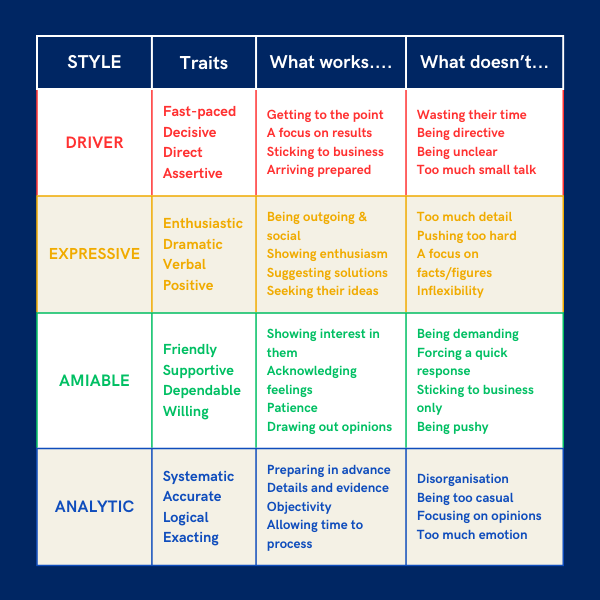Flexing Our Communication Style Authentically
Understanding our own, and others’ predominant communication style/s can improve understanding and decrease frustration and conflict. Being able to flex our style authentically to better connect with others can be particularly effective.
I was coaching a Chief Marketing Officer. Let’s call him Andy. He had just come back from an exhibition where he’d been discussing a new Customer Data Management platform with potential suppliers. He arrived for our online coaching session very excited. He was full of examples of other companies’ positive experience using this software. Naturally persuasive, he can’t wait to tell his fellow Exec Team members about it.
Andy has a lot of Expressive traits, while several of his colleagues are naturally more Analytical. They value evidence, detail, rigour, data. How are they likely to respond to Andy’s enthusiastic presentation with testimonials and examples about a potential new CRM platform? What would their response be to Andy’s great ideas and enthusiasm? Not necessarily that positive.
What do his Analytically-oriented colleagues need to take his proposal seriously? Facts, numbers, ROI. If Andy can provide this to them, they are more likely to take his proposition more seriously.
Flexing our style involves understanding what’s important to the other person, and tailoring our approach to better connect with them.. Remember, most people are a mix of styles, so we may need to blend our approach.
How to Flex Your Communication Style Authentically
Once we’ve identified our colleagues’ communication styles, we can tailor our approach to working with them. Here are some tips:
What happens when you try to gently flex your own style to better connect with others?
How can we flex our style when communicating with lots of people?
It’s one thing to adapt our communication style to our audience in a 1:1 situation. But what about when we’re in a meeting with a varied group of communicators? This is a daily occurrence for most of us.
The Z Tool can help us here. It speaks in turn to the amiable, expressive, analytical and driver traits. For example:
Imagine you’d like to introduce a new platform to manage the patient journey (personal information, medical history, appointments, surgery, medication etc). Using the Z Tool you might say:
‘We’ve been using our current platform for many years. It’s familiar to us and has enabled us to serve our patients well.’ (Here we’re appealing to those with high Amiable traits.)
‘What we know though is that things evolve. There are new platforms out there that can improve the patient experiences and give us more flexibility and control.’ (Here we’re appealing to those with more Expressive traits.)
‘What is the functionality of these new platforms and how much do they cost?’ (These are some of the questions those with high Analytical traits will ask). We’ve enquired with three potential suppliers and have initial costs, functionality, timelines etc.’
‘So why do this? Introducing a new platform will enable us to treat patients faster and more effectively, leading to better patient outcomes. This will reduce mistakes, missed appointments, increase occupancy in operating theatres, and positively influence the bottom line.’ (This is addressing the questions those with Driver traits have).
Questions to consider: When might you use this technique?
What preparation would help you feel more confident?
If you’re interested in developing your own, or your team’s communication skills through executive coaching or our Effective Leadership Training programmes do contact me.
Kate Jennings


